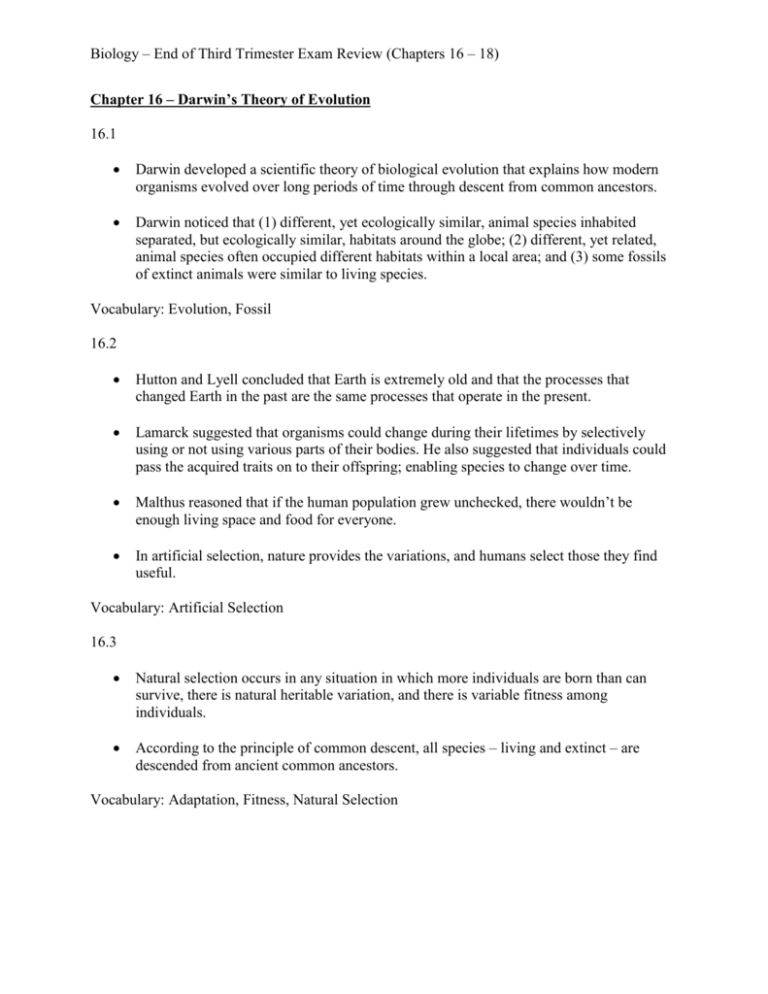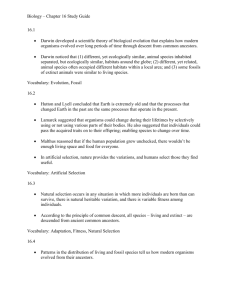18 - Barnstable Academy
advertisement

Biology – End of Third Trimester Exam Review (Chapters 16 – 18) Chapter 16 – Darwin’s Theory of Evolution 16.1 Darwin developed a scientific theory of biological evolution that explains how modern organisms evolved over long periods of time through descent from common ancestors. Darwin noticed that (1) different, yet ecologically similar, animal species inhabited separated, but ecologically similar, habitats around the globe; (2) different, yet related, animal species often occupied different habitats within a local area; and (3) some fossils of extinct animals were similar to living species. Vocabulary: Evolution, Fossil 16.2 Hutton and Lyell concluded that Earth is extremely old and that the processes that changed Earth in the past are the same processes that operate in the present. Lamarck suggested that organisms could change during their lifetimes by selectively using or not using various parts of their bodies. He also suggested that individuals could pass the acquired traits on to their offspring; enabling species to change over time. Malthus reasoned that if the human population grew unchecked, there wouldn’t be enough living space and food for everyone. In artificial selection, nature provides the variations, and humans select those they find useful. Vocabulary: Artificial Selection 16.3 Natural selection occurs in any situation in which more individuals are born than can survive, there is natural heritable variation, and there is variable fitness among individuals. According to the principle of common descent, all species – living and extinct – are descended from ancient common ancestors. Vocabulary: Adaptation, Fitness, Natural Selection Biology – End of Third Trimester Exam Review (Chapters 16 – 18) 16.4 Patterns in the distribution of living and fossil species tell us how modern organisms evolved from their ancestors. Many recently discovered fossils form series that trace the evolution of modern species from extinct ancestors. Evolutionary theory explains the existence of homologous structures adapted to different purposes as the result of descent with modification from a common ancestor. The universal genetic code and homologous molecules provide evidence of common descent. The grants have documented that natural selection takes place in wild Galapagos finch populations frequently, and sometimes rapidly, and that variation within a species increases the likelihood of the species adapting to the surviving environmental change. Vocabulary: Biogeography, Homologous Structure, Analogous Structure, Vestigial Structure Chapter 17 – Evolution of Populations 17.1 Evolution is a change in the frequency of alleles in a population over time. Three sources of genetic variation are mutation, genetic recombination during secual reproduction, and lateral gene transfer. The number of phenotypes produced for a trait depends on how many genes control the trait. Vocabulary: Gene Pool, Allele Frequency, Single-Gene Trait, Polygenic Trait 17.2 Natural selection on single-gene traits can lead to changes in allele frequencies and, thus, to changes in phenotype frequencies. Natural selection on polygenic traits can affect the relative fitness of phenotypes and thereby produce one of the three types of selection: directional selection, stabilizing selection, or disruptive selection. In small populations, individuals that carry a particular allele may leave more descendents than other individuals leave, just by chance. Over time, a series of chance occurrences can cause an allele to become more or less common in a population. The Hardy-Weinberg principle predicts that five conditions can occur: (1) nonrandom mating; (2) small population size; and (3) immigration or emigration; (4) mutations; or (5) natural selection. Biology – End of Third Trimester Exam Review (Chapters 16 – 18) Vocabulary: Directional Selection, Stabilizing Selection, Disruptive Selection, Genetic Drift; Bottleneck Effect, Founder Effect, Genetic Equilibrium, Hardy-Weinberg Principle, Sexual Selection 17.3 When populations become reproductively isolated, they can evolve into two separate species. Reproductive isolation can develop in a variety of ways, including behavioral isolation, geographic isolation, and temporal isolation. Speciation in the Galapagos finches most likely occurred by founding of a new population, geographic isolation, changes in the new population’s gene pool, behavioral isolation, and ecological competition. Vocabulary: Species, Speciation, Reproductive Isolation, Behavioral Isolation, Geographic Isolation, Temporal Isolation 17.4 A molecular clock uses mutation rates in DNA to estimate the time that two species have been evolving independently. One way in which new genes evolve is through the duplication, and then modification, of existing genes. Small changes in Hox gene activity during embryological development can produce large changes in adult animals. Vocabulary: Molecular Clock Chapter 18 – Classification 18.1 In binomial nomenclature, each species is assigned a two-part scientific name. The goal of systematic is to organize living things into groups that have biological meaning. Over time, Linneau’s original classification system expanded to include seven hierarchical taxa: Species, Genus, Family, Order, Class, Phylum, and Kingdom. Vocabulary: Binomial Nomenclature, Genus, Systematics, Taxon, Family, Order, Class, Phylum, Kingdom Biology – End of Third Trimester Exam Review (Chapters 16 – 18) 18.2 The goal of phylogenetic systematic, or evolutionary classification, is to group species into larger categories that reflect lines of evolutionary descent, rather than overall similarities and differences. A cladogram links groups of organisms by showing how evolutionary lines, or lineages, branched off from common ancestors. In general, the more derived genetic characteristics two species share, the more recently they shared a common ancestor and the more closely they are related in evolutionary terms. Vocabulary: Phylogeny, Clade, Monophyletic Group, Cladogram, Derived Character 18.3 The six-kingdom system of classification includes the kingdoms Eubacteria, Archeabacteria, Protista, Fungi, Plantae, and Animalia. The tree of life shows current hypotheses regarding evolutionary relationships among the taxa within the three domains of life. Vocabulary: Domain, Bacteria, Archaea, Eukarya









